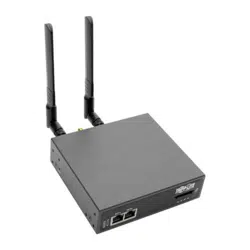Loading ...
Loading ...
Loading ...

42
4. Serial Port, Host, Device and User Configuration
4.1.8 USB Consoles
B093, B097, and B098 model console servers running firmware 3.16.5 or later support USB console connections to devices
from a wide range of vendors, including Cisco, HP, Dell and Brocade. All the USB ports on these console servers can also
function as plain RS-232 serial ports when a USB-to-serial adapter is connected.
These USB ports are available as regular port manager ports and are presented numerically in the web UI after all RJ45 serial
ports.
The RJ45 serial ports are presented in Serial & Network > Serial Port.
The common settings (baud rate, etc.) are used when configuring the ports. Some operations (e.g., sending serial breaks) may
not work, depending on the implementation of the underlying USB serial chip.
4.1.9 Link Layer Discovery Protocol (LLDP)
The Link Layer Discovery Protocol (LLDP) is a protocol that allows system administrators to gather information about devices
physically connected to managed switches. It is available for use on B093-Series devices.
The LLDP service is enabled through the System > Services page. When the service is enabled, the lldpd daemon is loaded
and running. The Service Access tab controls which network interfaces are monitored by the lldpd daemon.
When LLDP is granted access to an interface, it will use that interface, even if the interface has been disabled through
System > IP.
LLDP neighbors are visible through the Status > LLDP Neighbors page. This page shows neighbors detected and indicates
the console manager is sending information.
Note: Although the LLDP service can be granted access to non-Ethernet interfaces (for example, G3, G4 and PSTN dial-up interfaces), it
currently ignores non-Ethernet interfaces.
The lldpcli shell client interacts with and configures the running LLDP service.
Persistent custom configuration changes can be added to the system through configuration files placed in /etc/config/lldpd.d/.
Custom configuration files (which must have filenames ending with .conf) will be read and executed by lldpcli when the LLDP
service starts.
The /etc/ directory is read-only on Tripp Lite hardware. Most default configuration files otherwise stored in /etc/ are on Tripp Lite
hardware in /etc/config/, which is writeable.
The default lldpd configuration file lldpd.conf is saved in /etc/config/ on Tripp Lite hardware. It is not safe to save custom
configuration details. There are circumstances in which this file is regenerated automatically, in which case all customizations
will be lost.
The etc/config/lldpd.d/ directory, which is also writable and created on first boot is safe to write to. Any Custom LLDP
configurations must be stored as *.conf files in this directory.
When enabled, LLDP frames issued by a Tripp Lite Console Manager will reveal sensitive information such as hostname and
firmware version.
LLDP frames are not passed through by 802.3ab compliant switches. Tripp Lite Console Managers have the LLDP service
disabled by default.
Both lldpd and lldpcli have standard manual pages but because of space concerns, these pages are not shipped with
Tripp Lite hardware. However, both manual pages are available on the lldpd project: man lldpd can be found at
https:// vincentbernat.github.io/lldpd/usage.html#lldpd8; and man lldpcli can be found at
https:// vincentbernat.github.io/lldpd/usage.html#lldpcli8.
Note: Tripp Lite uses lldpd 0.9.2.
Loading ...
Loading ...
Loading ...
